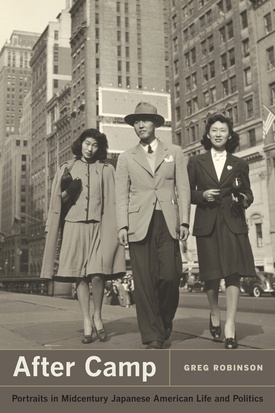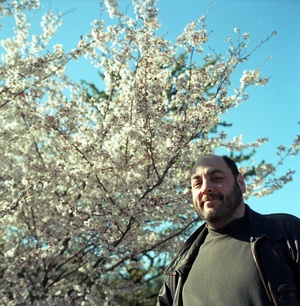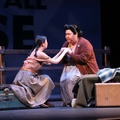The wartime roundup and removal from the West Coast of 120,000 American citizens and permanent residents of Japanese ancestry has generated an enormous literature, including important contributions from Dr. Greg Robinson. But the postwar period of resettlement and renewal of Japanese American communities, largely unstudied, is also compelling and deserving of attention. Robinson, Professor of History at l’Université du Québec À Montréal, has just published the first in-depth look at this period in After Camp: Portraits in Midcentury Japanese American Life and Politics.
Through a series of essays grouped into five broad thematic sections, After Camp examines the difficulties and tensions confronting Japanese Americans as they rebuilt their lives after the war. Released from confinement to face restrictive covenants, prejudice and persecution, their struggle to assimilate and integrate was formidable. Japanese Americans employed a number of strategies, from the formation of organizations and neighborhoods that reinforced their ethnic identity to the development of alliances with other minority groups to amplify their political voice.
Hoping to promote assimilation and reduce racial conflict, President Roosevelt and his administration supported a policy of dispersal—scattering uprooted Japanese Americans throughout the U.S. Japanese American communities grew in the Midwest and East, the subject of an essay that compares the rebirth of Japanese communities in Detroit, New York, and Los Angeles. In the end, dispersal was largely unsuccessful because, once freed, many former camp inmates chose to return to familiar territory on the West Coast. Even in cities outside the West Coast, race-based covenants and restrictions forced various ethnic minorities to live in close proximity.
In addition to resettlement and assimilation, After Camp also looks at the social, cultural, and political relations among Japanese Americans, Mexican Americans, and Jews. The last two sections of After Camp follow Japanese Americans and African Americans in their tandem struggle for civil rights. Most compelling is the straight line Robinson draws from Japanese American legal battles to the landmark Supreme Court decision, Brown v. The Board of Education. Yet in all these cases, mutual distrust and the reality of ethnic bias within minority groups ultimately weakened interracial activism.
Dr. Robinson will discuss After Camp at the Japanese American National Museum (JANM) on March 2, 2013 at 2:00pm.
Meet Greg Robinson
After Camp is Dr. Robinson’s third solo book about Japanese Americans in the World War II era. An award-winning author, Robinson first explored the history of government decisions that led to Executive Order 9066 in By Order of the President: FDR and the Internment of Japanese Americans (Harvard University Press, 2001). This bestseller was named a “Recommended Book for Understanding Civil Liberties” by the American Association of University Presses. Robinson followed up with a second monograph, A Tragedy of Democracy: Japanese Confinement in North America (Columbia University Press, 2009) which won the 2009 History Book Prize of the Association for Asian American Studies.
Robinson, a native New Yorker, became especially interested in Japanese Americans fifteen years ago as a graduate student digging through files on Franklin Delano Roosevelt at the FDR Library in Hyde Park. During an extended break from his studies, a journal editor asked Robinson to contribute an article on the Roosevelt Administration. Robinson reviewed some of FDR’s writings from the 1920s and described what followed:
I discovered to my great surprise that FDR had written an article and other pieces on diplomatic relations between the US and Japan, which he wanted to improve, and that he had declared that the largest sticking point between the nations was the question of Japanese immigration. FDR concluded that the laws that excluded Japanese immigrants from coming and forbade those already in the country from becoming citizens or owning property were all justified because they preserved “racial purity,” as he called it, against intermarriage. I thought, well, if this was what Roosevelt thought in the 1920s, was there some relation to what he thought in the 1940s? I soon discovered that there was a hole in the existing literature—nobody had written adequately about FDR’s role in internment. I thus decided to go back to my studies in order to figure it all out. In the process, my planned article grew to a dissertation, and then a book. In the process, I realized just how much the wartime removal of Japanese Americans has influenced American society, culture, and law.
Addressing Terminology—“Inmate” or “Internee”
There is a continuing debate over terminology, which suggests the raw power exerted by the wartime events, and also the really unprecedented nature of the government’s policy. Each of my first two books included a Note on Terminology, which reflected my attempts to wrestle with the issue and to promote understanding. I used “Internment” (though capitalized in an attempt to distinguish it) and “internee” in By Order of the President, as these seemed to me the most common and easily-understood words. As scholars and activists seemed to coalesce against the word “internment” during the 2000s (in the same way that “Black” replaced “Negro” as a term for those of African ancestry during the 1960s) I decided to phase out using it. Once I began work on A Tragedy of Democracy, in which I studied the wartime treatment of the Latin American Japanese, the Japanese Mexicans, and the Japanese Canadians alongside that of Japanese Americans, it struck me that the official policies were so wide-ranging and complicated that some handy overall term was needed. I decided to use “confinement” for the official policy. I then hit on “inmate” as both a flexible and slightly ominous way to describe those subjected to involuntary confinement—a person can be an inmate of a hospital or institution as well as of a penitentiary. I did not want to use “prisoner” or “incarceration,” which I thought troublesome. I continued to use these terms in After Camp. Some people have adopted them, and others have not.
On the challenges of interracial activism:
I pay a good deal of attention in After Camp to both the successes and problems that racial/ethnic minorities have in forming alliances. Tensions and hostility can arise among minorities, even when they face similar prejudice. My late aunt used to tell the story of being taken as a girl, circa 1950, to visit Lake George, a resort in upstate New York with a largely Jewish clientele. There she and her aunt found a woman by the poolside loudly denouncing Puerto Ricans as dirty and unpleasant. As fellow Jews, they were embarrassed by such open prejudice. Then they saw that the woman had a number tattooed on her arm and realized that she was a Holocaust survivor. “If you don’t learn in a CONCENTRATION CAMP,” said the aunt scornfully,“ WHERE are you going to LEARN?”
On JANM’s role in telling the postwar story:
As I say in the introduction to After Camp, “If the generation of resettlement and renewal that followed the release of inmates from camp lacks the massive drama and conflict of the wartime events, it must be accounted equally important, if not more so, in setting the course of mainland Japanese American life.” I believe that it is vital to think about and study the postwar story, and that JANM has a special challenge and opportunity in developing it. JANM is especially well placed, it seems to me, to delve into the essential question of postwar intergroup relations. After all, the museum is located in the area that in the years after camp was known as Little Tokyo-Bronzeville, which was a population center for African Americans as well as Issei and Nisei. It also is next to the historic Little Manila area and to Mexican-American districts. Furthermore, both the museum exhibitions and the Center for the Preservation of Democracy are designed to attract and to reach out to diverse groups.
What’s next for the history of postwar Japanese Americans:
I am pursuing various projects on the postwar Nikkei experience. Sedai, the Japanese Canadian Legacy Project, and the Japanese Canadian Cultural Centre in Toronto have been organizing efforts to uncover the experience of Japanese Canadians after camp. I am very honored to join in this work. I also am expanding my studies of the history of alliances between Japanese Americans and Blacks, both their wartime origins and their later impact on the Japanese American redress movement. A number of the articles I write for “The Great Unknown,” the historical column I contribute to the Nichi Bei Weekly newspaper, deal with postwar events. Still, I can’t do it all myself, and anyway would not want to. Rather, my goal in writing After Camp was to provide a first look at a complex and largely uncovered subject, and to get other people to pay more attention to it. I think of After Camp as a kind of starting gun. In a real sense, I am just waiting for other people to come test my ideas and engage with me.
* * *
Books & Conversations
After Camp: Portraits in Midcentury Japanese American Life and Politics by Dr. Greg Robinson
Saturday, March 2, 2013 • 2PM
Japanese American National Museum
Los Angeles, California
The book is available for purchase through the JANM online store >>
© 2013 Esther Newman








